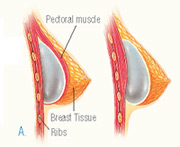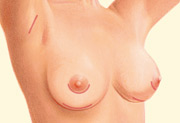
Breast Augmentation
What is breast augmentation?
Breast augmentation is a common surgical procedure that increases the size and shape of your breasts. Your breasts can be augmented using breast implants or fat transfer.
Breast augmentation, sometimes referred to as a “breast aug” or “boob job” by patients, involves using breast implants or fat transfer to increase the size of your breasts. This procedure can also restore breast volume lost after weight reduction or pregnancy, achieve a more rounded breast shape or improve natural breast size asymmetry.

Who is a good candidate for breast augmentation?
Breast augmentation is a deeply personal procedure, and it’s important that you’re doing it for yourself and not for someone else, even if that person has offered to pay for it. Patient satisfaction is high, specifically when they want the procedure themselves.
You may be a candidate for breast augmentation if:
- You are physically healthy and you aren’t pregnant or breastfeeding
- You have realistic expectations
- Your breasts are fully developed
- You are bothered by the feeling that your breasts are too small
- You are dissatisfied with your breasts losing shape and volume after pregnancy, weight loss or with aging
- You are unhappy with the upper part of your breast appearing “empty”
- Your breasts are asymmetrical
- One or both breasts failed to develop normally or have an elongated shape
What types of breast implants are available?
Saline breast implants
Saline breast implants are filled with sterile salt water. Should the implant shell leak, a saline implant will collapse and the saline will be absorbed and naturally expelled by the body.
Saline breast implants provide a uniform shape, firmness and feel, and are FDA-approved for augmentation in women age 18 or older.
Structured saline breast implants
Structured implants are filled with sterile salt water, and contain an inner structure which aims to make the implant feel more natural.
Silicone breast implants
Silicone breast implants are filled with silicone gel. The gel feels a bit more like natural breast tissue. If the implant leaks, the gel may remain within the implant shell, or may escape into the breast implant pocket. A leaking implant filled with silicone gel will not collapse.
If you choose silicone implants, you may need to visit your plastic surgeon regularly to make sure the implants are functioning properly. An ultrasound or MRI screening can assess the condition of breast implants.
Silicone breast implants are FDA-approved for augmentation in women age 22 or older.
Gummy bear breast implants
Form-stable implants are sometimes referred to as gummy bear breast implants because they maintain their shape even when the implant shell is broken.
The consistency of the silicone gel inside the implant is thicker than traditional silicone gel implants. These implants are also firmer than traditional implants.
Shaped gummy bear breast implants have more projection at the bottom and are tapered towards the top. If a shaped implant rotates, it may lead to an unusual appearance of the breast that requires a separate procedure to correct.
Placement of gummy bear implants requires a slightly longer incision in the skin.
Round breast implants
Round breast implants have a tendency to make breasts appear fuller than form-stable implants. Higher profile options can achieve even more projection.
Because round implants are the same shape all over, there is less concern about them rotating out of place.
Smooth breast implants
Smooth breast implants are the softest feeling. They can move with the breast implant pocket, which may give more natural movement.
Smooth implants may have some palpable or visible rippling under the skin.
Textured breast implants
Textured breast implants develop scar tissue to stick to the implant, making them less likely to move around inside of the breast and become repositioned.
Texturing offers some advantage in diminishing the risk of a tight scar capsule.
*It’s important to note that breast implant-associated anaplastic large cell lymphoma (BIA-ALCL) occurs most frequently in patients who have breast implants with textured surfaces. For more information on BIA-ALCL, visit our BIA-ALCL Summary page. Discuss all benefits and risks related to your breast implant procedure with your board-certified plastic surgeon. Understanding all potential risk factors will help with better decision-making that is best for you and your health.
Implant manufacturers occasionally introduce new styles and types of breast implants, so there may be additional options available.
Whether you choose saline or silicone implants, it is important for you to monitor your breast implants and follow-up with your plastic surgeon for appropriate checkups.
What are the steps of a breast augmentation procedure?
A breast augmentation procedure includes the following steps:
Step 1 – Anesthesia
Medications are administered for your comfort during the surgical procedure. The choices include intravenous sedation and general anesthesia. Your doctor will recommend the best choice for you.
Step 2 – The incision
Incisions are made in inconspicuous areas to minimize visible scarring. You and your plastic surgeon will discuss which incision options are appropriate for your desired outcome. Incision options include: along the areolar edge (peri-areolar incision), the fold under the breast (inframammary fold) and in the armpit (axillary incision). A belly-button approach is associated with a higher complication rate.

Incisions vary based on the type of breast implant, degree of enlargement desired, your particular anatomy and patient-surgeon preference.
Step 3 – Inserting and placing the breast implant
After the incision is made, a breast implant is inserted into a pocket either:

A. Under the pectoral muscle (a submuscular placement)
B. Directly behind the breast tissue, over the pectoral muscle (a submammary/ subglandular placement)
The method for inserting and positioning breast implants depends on the type of implant, degree of enlargement desired, your body type and your surgeon’s recommendations.
Step 4 – Closing the incisions
Incisions are closed with layered sutures in the breast tissue and with sutures, skin adhesive or surgical tape to close the skin.

Over time the incision lines will fade. The quality of scar depends on many things, including your genetics, exposure of your body to nicotine and infection.
Step 5 – See the results
The results of breast augmentation are immediately visible. Get more information about breast augmentation results.

